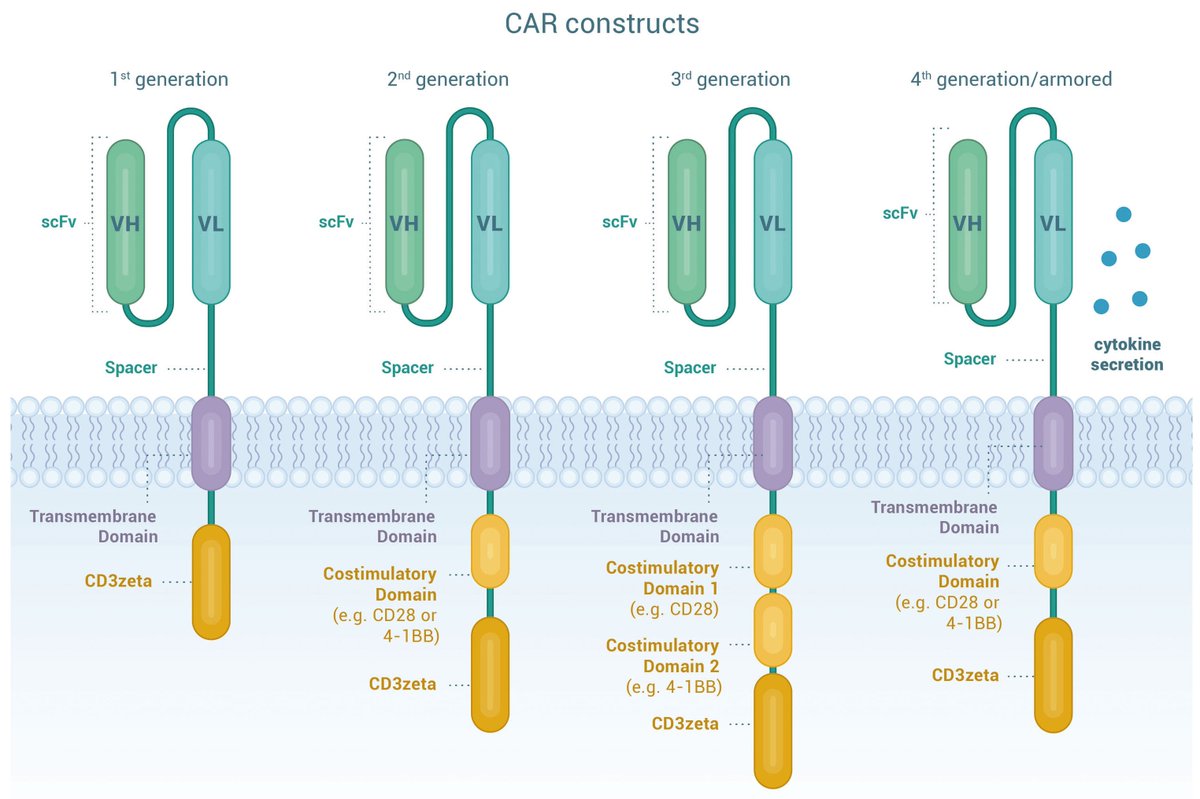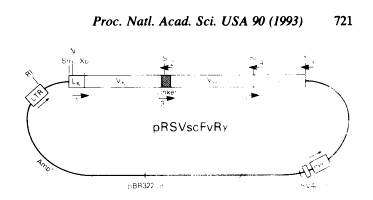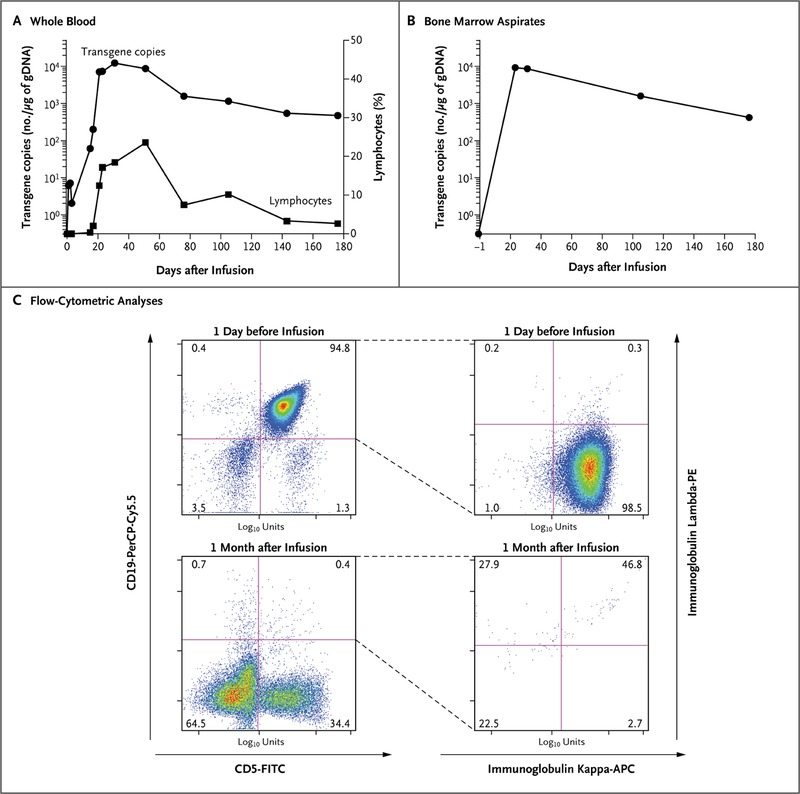Chimeric antigen receptor (CAR) T-cells have changed treatment avenues in #hematology, providing new hope for patients.
Its road started quite recently, with highs and lows; and it remains a very complex and expensive treatment.
A short 🧵about its history.
#MedTwitter
Its road started quite recently, with highs and lows; and it remains a very complex and expensive treatment.
A short 🧵about its history.
#MedTwitter

1/
CAR-background I:
-designer proteins that redirect T-cells👉antigen on tumor cells
-4 essential components: extracellular antigen recognition domain, hinge or spacer moiety, transmembrane domain, and intracellular signaling domains
-4 generations so far and still evolving
CAR-background I:
-designer proteins that redirect T-cells👉antigen on tumor cells
-4 essential components: extracellular antigen recognition domain, hinge or spacer moiety, transmembrane domain, and intracellular signaling domains
-4 generations so far and still evolving

2/
CAR-background II:
-extracellular target-binding site is most important factor👉 lock and key for target antigen
specificity
-against a well-documented target on tumor cell surface
-appropriate antigen most crucial component for CAR T-cell activity👉across cancers (selected👇)
CAR-background II:
-extracellular target-binding site is most important factor👉 lock and key for target antigen
specificity
-against a well-documented target on tumor cell surface
-appropriate antigen most crucial component for CAR T-cell activity👉across cancers (selected👇)

3/
1960:
-seminal paper by Eva and George Klein
-dissected essential basis of modern tumour immunology
-before, researchers thought all cancers carried a common antigen
-demonstrated that the immune system would only reject cancerous cells if they came from the original tumour
1960:
-seminal paper by Eva and George Klein
-dissected essential basis of modern tumour immunology
-before, researchers thought all cancers carried a common antigen
-demonstrated that the immune system would only reject cancerous cells if they came from the original tumour

4/
1961:
-Miller studied mice and discovered that the thymus actually makes lymphocytes (T-cells) and sends them out into the rest of the body where they fight infections
👉too many T-cells can cause leukemia
👉T-cells can attack the body’s own cells👉autoimmune disease
1961:
-Miller studied mice and discovered that the thymus actually makes lymphocytes (T-cells) and sends them out into the rest of the body where they fight infections
👉too many T-cells can cause leukemia
👉T-cells can attack the body’s own cells👉autoimmune disease

5/
60s to 80s:
-attempts to treat hosts with adoptively transferred cells immune to tumor antigens have been unsuccessful
-bone marrow transplants were studied and improved from the 70s👉first real immunotherapy
See history of BMT in another 🧵
60s to 80s:
-attempts to treat hosts with adoptively transferred cells immune to tumor antigens have been unsuccessful
-bone marrow transplants were studied and improved from the 70s👉first real immunotherapy
See history of BMT in another 🧵
https://twitter.com/NicoGagelmann/status/1600696971831889925?s=20
6/
1982, development of methods:
-to isolate tumor and virus-reactive T-cells
-to generate sufficient numbers of poten-
tial effector cells
-human tumors express antigens, serving as targets for tumor lysis
-graft-versus-leukemia reaction after BMT
1982, development of methods:
-to isolate tumor and virus-reactive T-cells
-to generate sufficient numbers of poten-
tial effector cells
-human tumors express antigens, serving as targets for tumor lysis
-graft-versus-leukemia reaction after BMT

7/
1986, breakthrough:
-Rosenberg et al. @theNCI
-ccyclophosphamide + tumor-infiltrating lymphocytes (TIL) + IL-2👉100% of mice were cured of advanced cancer
-techniques developed to isolate TIL from human tumors
👉rationale for the use of TIL in the treatment of humans
1986, breakthrough:
-Rosenberg et al. @theNCI
-ccyclophosphamide + tumor-infiltrating lymphocytes (TIL) + IL-2👉100% of mice were cured of advanced cancer
-techniques developed to isolate TIL from human tumors
👉rationale for the use of TIL in the treatment of humans

8/
1987:
-Kuwana et al. onstructed chimeric genes composed of immunoglobulin (Ig)-derived variable regions and T-cell receptor-derived constant regions
-2 pairs of chimeric genes were inserted into an expression vector containing both Ecogpt and neo genes
1987:
-Kuwana et al. onstructed chimeric genes composed of immunoglobulin (Ig)-derived variable regions and T-cell receptor-derived constant regions
-2 pairs of chimeric genes were inserted into an expression vector containing both Ecogpt and neo genes

9/
1987, hematotoxicity:
-Rosenberg et al.
-IL-2 + lymphokine-activated killer (LAK) cells from autologous lymphocytes
-80% patients developed anemia that required transfusions, 1/2 showed severe thrombopenia
👉effects may result from IL-2-mediated suppression of hematopoiesis
1987, hematotoxicity:
-Rosenberg et al.
-IL-2 + lymphokine-activated killer (LAK) cells from autologous lymphocytes
-80% patients developed anemia that required transfusions, 1/2 showed severe thrombopenia
👉effects may result from IL-2-mediated suppression of hematopoiesis

10/
1989:
-Gross et al. (Israel)
-chimeric receptor provides the T cell with an antibody-like specificity and is able to effectively transmit the signal for T-cell activation and execution of its effector function
1989:
-Gross et al. (Israel)
-chimeric receptor provides the T cell with an antibody-like specificity and is able to effectively transmit the signal for T-cell activation and execution of its effector function

11/
90s:
-dual-edged role played by T lymphocytes (1. versus tumor, 2. versus host) spurred a search to identify beneficial & deleterious cells
-spawned donor leukocyte infusion and virus-specific T-cells
👉How to control composition of T-cell products?
90s:
-dual-edged role played by T lymphocytes (1. versus tumor, 2. versus host) spurred a search to identify beneficial & deleterious cells
-spawned donor leukocyte infusion and virus-specific T-cells
👉How to control composition of T-cell products?
12/
1993:
-1st generation of CARs by Eshhar et al.
-designed and constructed chimeric genes composed of a single-chain Fv domain (scFv) of an antibody linked with gamma or zeta chains, the common signal-transducing subunits of the immunoglobulin receptor and the TCR
1993:
-1st generation of CARs by Eshhar et al.
-designed and constructed chimeric genes composed of a single-chain Fv domain (scFv) of an antibody linked with gamma or zeta chains, the common signal-transducing subunits of the immunoglobulin receptor and the TCR

13/
1998, costimulation:
-Prof. Sadelain et al. @MSKCancerCenter showed that introducing a co-stimulatory molecule (CD28) into engineered T-cells allowed them to persist and remain active
👉potential for new generation of CARs
1998, costimulation:
-Prof. Sadelain et al. @MSKCancerCenter showed that introducing a co-stimulatory molecule (CD28) into engineered T-cells allowed them to persist and remain active
👉potential for new generation of CARs

14/
2003, evidence for systemic tumors:
-Brentjens et al. showed expanding peripheral blood T cells genetically targeting CD19 antigen in presence of CD80 + IL-15
-anti-tumor activity is further enhanced by in vivo co-stimulation
-active against human chronic lymphocytic leukemia
2003, evidence for systemic tumors:
-Brentjens et al. showed expanding peripheral blood T cells genetically targeting CD19 antigen in presence of CD80 + IL-15
-anti-tumor activity is further enhanced by in vivo co-stimulation
-active against human chronic lymphocytic leukemia

15/
2007:
-first clinical study with 2nd generation CD19 CAR-T cell therapy in B-cell malignancy @MSKCancerCenter
2007:
-first clinical study with 2nd generation CD19 CAR-T cell therapy in B-cell malignancy @MSKCancerCenter

16/
2011, CLL study:
-Porter, Levine, June et al. designed a lentiviral vector expressing a CD19 CAR, costimulation with 4-1BB, and CD3-zeta signaling
-remission ongoing 10 months after treatment
-lymphopenia & hypogammaglobulinemia as an expected chronic toxic effect
2011, CLL study:
-Porter, Levine, June et al. designed a lentiviral vector expressing a CD19 CAR, costimulation with 4-1BB, and CD3-zeta signaling
-remission ongoing 10 months after treatment
-lymphopenia & hypogammaglobulinemia as an expected chronic toxic effect

17/
2022, follow-up CLL:
-in 2 patients
-CAR T cells detectable >10 years after infusion, with sustained remission in both patients
👉highly activated CD4+ population
👉exhibited cytotoxic characteristics along with ongoing functional activation and proliferation


2022, follow-up CLL:
-in 2 patients
-CAR T cells detectable >10 years after infusion, with sustained remission in both patients
👉highly activated CD4+ population
👉exhibited cytotoxic characteristics along with ongoing functional activation and proliferation



18/
Until now:
2017 was the year with the first FDA approval for CD19-directed CAR T cells for relapsed, refractory acute lymphoblastic leukemia in children and young adults. Since then, others have been approved for different indications. Full list: fda.gov/vaccines-blood…
Until now:
2017 was the year with the first FDA approval for CD19-directed CAR T cells for relapsed, refractory acute lymphoblastic leukemia in children and young adults. Since then, others have been approved for different indications. Full list: fda.gov/vaccines-blood…
This short view can only fail to capture all aspects. CAR-T still is complex and very expensive and not accessible in most parts of the world! However, the beauty of the field is the engineering and innovation & I hope we find ways for accessible & affordable therapies!
All these works originate from amazing researchers, groups and institutions such as @theNCI @MSKCancerCenter @fredhutch @Penn and living legends eg Carl June, Michel Sadelain, Bruce Levine and many more I cannot give justice here. Forgive me, you are all idols!
Helpful resources and references:
nature.com/articles/54229…
discovery.wehi.edu.au/timeline/thymu…
link.springer.com/chapter/10.100…
mskcc.org/timeline/car-t…
annualreviews.org/doi/pdf/10.114…
ncbi.nlm.nih.gov/pmc/articles/P…
nature.com/articles/54229…
discovery.wehi.edu.au/timeline/thymu…
link.springer.com/chapter/10.100…
mskcc.org/timeline/car-t…
annualreviews.org/doi/pdf/10.114…
ncbi.nlm.nih.gov/pmc/articles/P…
• • •
Missing some Tweet in this thread? You can try to
force a refresh




















